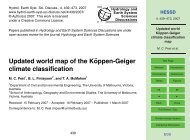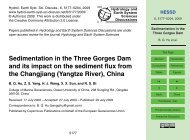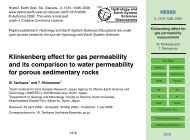In-situ evaluation of internal drainage in layered soils (Tukulu - hessd
In-situ evaluation of internal drainage in layered soils (Tukulu - hessd
In-situ evaluation of internal drainage in layered soils (Tukulu - hessd
You also want an ePaper? Increase the reach of your titles
YUMPU automatically turns print PDFs into web optimized ePapers that Google loves.
5<br />
10<br />
15<br />
20<br />
25<br />
5<br />
10<br />
15<br />
20<br />
<strong>In</strong> the Sepane and <strong>Tukulu</strong> a more central position was selected and monoliths <strong>of</strong><br />
(4 m × 4 m) × 1 m depth were prepared with three connected replications. Monoliths<br />
were centrally fitted with three neutron access tubes to a depth <strong>of</strong> 1.1 m. On the Swartland,<br />
the monoliths were detached and setup at 30 m distance apart with dimensions<br />
<strong>of</strong> (1.2 m × 1.2 m) × 0.5 m depth. Shallow depths on the Swartland allowed the use <strong>of</strong><br />
DFM probe loggers at depths <strong>of</strong> 0.6 m. All monoliths were laterally isolated with plastic<br />
sheet to prevent lateral water movement. An earth bund was made to form a ridge<br />
around the monoliths to isolate them from surface run<strong>of</strong>f and to support pond<strong>in</strong>g.<br />
Before soil water content (SWC) measurements commenced the monoliths were<br />
ponded with water for three days until it was presumed to have reached field saturation.<br />
At the end <strong>of</strong> the 3rd day the monoliths were covered and sealed at the surface<br />
with a polythene plastic upon depletion <strong>of</strong> ponded water. Measurements <strong>of</strong> SWC were<br />
taken us<strong>in</strong>g a neutron water probe (NWP) at 200, 500, 850 and 1100 mm depth <strong>in</strong>tervals.<br />
DFM probe loggers were set to take read<strong>in</strong>gs at every hour dur<strong>in</strong>g the entire<br />
<strong>dra<strong>in</strong>age</strong> period at depths <strong>of</strong> 100, 300 and 550 mm from the Swartland soil pr<strong>of</strong>ile.<br />
Over the first seven days SWC measurements were taken <strong>in</strong> the morn<strong>in</strong>g and afternoon<br />
and thereafter once a day for a 50 day period. The measured SWC that resulted<br />
<strong>in</strong> a <strong>dra<strong>in</strong>age</strong> flux <strong>of</strong> 0.001 mm h −1 was assumed to have reached the <strong>dra<strong>in</strong>age</strong> upper<br />
limit (DUL). At the beg<strong>in</strong>n<strong>in</strong>g <strong>of</strong> the field measurements both soil water <strong>in</strong>struments<br />
were calibrated for the respective soil pr<strong>of</strong>iles. From each horizon a soil sample was<br />
taken us<strong>in</strong>g an auger at a 250 mm distance from the NWP and DFM probe. Samples<br />
were weighed shortly after packag<strong>in</strong>g <strong>in</strong> paper bags. They were then oven dried at<br />
105 ◦ C for 24 h to obta<strong>in</strong> gravimetric water content from their <strong>in</strong>-<strong>situ</strong> bulk densities.<br />
2.3 Laboratory experimental setup and measurements<br />
Undisturbed soil core samples were taken from the centre <strong>of</strong> each horizon us<strong>in</strong>g a core<br />
sampler mounted on a hydraulic jack. Samples were then trimmed, sealed and transported<br />
to the laboratory for analysis <strong>of</strong> the soil water characteristics curve (SWCC).<br />
Sampl<strong>in</strong>g cores had an <strong>in</strong>ner diameter <strong>of</strong> 103 mm with a height <strong>of</strong> 77 mm.<br />
9803<br />
Preparation <strong>of</strong> samples and desorption experiment was carried out <strong>in</strong> two phases.<br />
Core samples and water used for saturation samples were <strong>in</strong>itially de-aired us<strong>in</strong>g a vacuum<br />
chamber pump set at −70 kPa for 48 h under room temperature. Subsequently,<br />
de-aired water was <strong>in</strong>troduced on the second chamber with de-aired core samples allow<strong>in</strong>g<br />
the <strong>in</strong>flow to wet samples from below. Ponded water outside the wetted sample<br />
was cut-<strong>of</strong>f before water level overtopped the core samples. Core samples were left on<br />
the water bath for 24 h to allow total saturation. Three replications were used for each<br />
horizon. Before commencement <strong>of</strong> the desorption experiment saturated samples were<br />
weighed and sealed to control evaporation.<br />
Although the desorption experiment <strong>in</strong>volved three phases from 0–10 kPa, 10–<br />
100 kPa and 100–1500 kPa, <strong>in</strong> this work only the first was illustrated to capture the<br />
SWCC dur<strong>in</strong>g <strong><strong>in</strong>ternal</strong> <strong>dra<strong>in</strong>age</strong>. This procedure <strong>in</strong>volved the hang<strong>in</strong>g soil water column<br />
tension cup method described by Dirksen (1999) and Dane and Hopmans (2002).<br />
Follow<strong>in</strong>g saturation the samples were weighted and water that dripped from the sample<br />
at weigh<strong>in</strong>g time was attributed to the porosity <strong>of</strong> the samples. Placed on ceramic<br />
cups prepared for this purpose hang<strong>in</strong>g 1000 mm from reference po<strong>in</strong>t samples, elevation<br />
height was gradually reduced at 100 mm <strong>in</strong>tervals for the entire 1000 mm. At every<br />
step, <strong>in</strong>terval samples were weighed before and after samples had equilibrated on the<br />
ceramic cups. Dur<strong>in</strong>g this experiment samples were covered with a foliar sheath to protect<br />
them from radiation. Consider<strong>in</strong>g that evaporation was assumed to be negligible<br />
under these conditions, change <strong>in</strong> samples mass was considered to be a true reflection<br />
<strong>of</strong> the amount <strong>of</strong> water that dra<strong>in</strong>ed from the samples. The result<strong>in</strong>g suction-SWC<br />
(θ-h) relationship was then regressed to estimate the correspond<strong>in</strong>g θ-h relationship to<br />
<strong><strong>in</strong>ternal</strong> <strong>dra<strong>in</strong>age</strong> <strong>of</strong> soil pr<strong>of</strong>iles horizons from saturation to <strong>dra<strong>in</strong>age</strong> upper limit (DUL).<br />
9804<br />
Discussion Paper | Discussion Paper | Discussion Paper | Discussion Paper |<br />
Discussion Paper | Discussion Paper | Discussion Paper | Discussion Paper |







